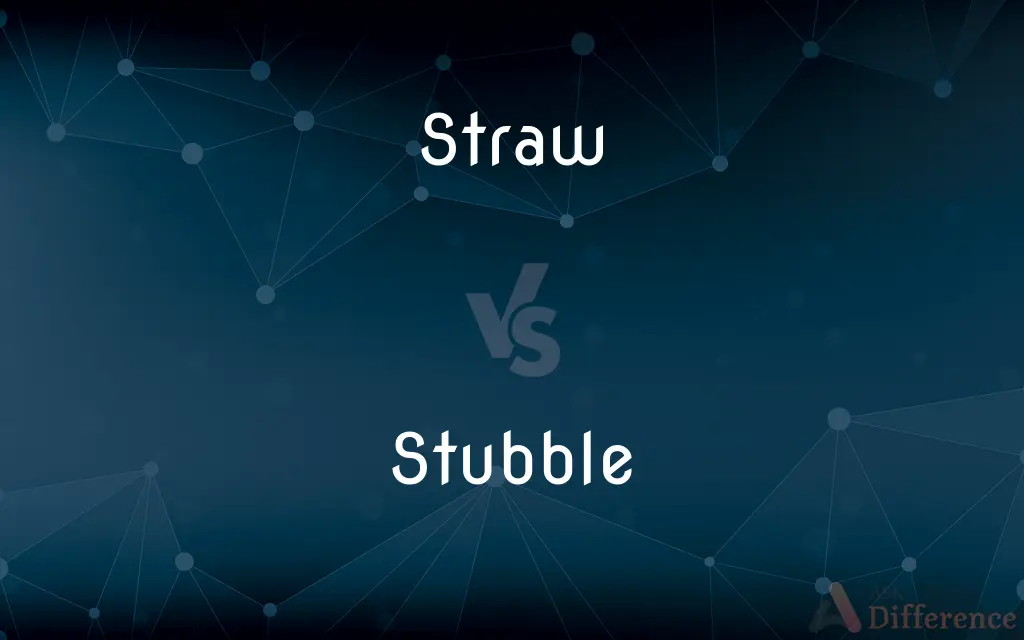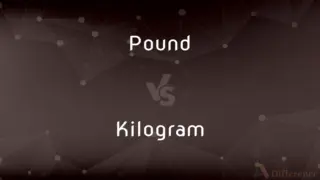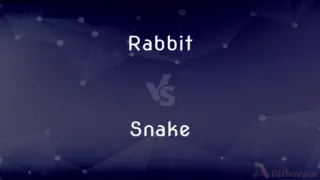Straw vs. Stubble — What's the Difference?
By Tayyaba Rehman & Urooj Arif — Updated on March 9, 2024
Straw is the dry stalks of cereal plants after grain removal, used for bedding and fodder, while stubble is the short stalks left in a field after harvesting.

Difference Between Straw and Stubble
Table of Contents
ADVERTISEMENT
Key Differences
Straw, originating from cereal plants like wheat, rice, and barley after the grain and chaff have been removed, is typically used in agricultural settings. Stubble, on the other hand, refers to the short stalks left protruding from the ground after the crop has been harvested.
Straw is collected and baled for transport and storage, making it a tradable commodity within agricultural and construction sectors. Stubble management is a critical aspect of post-harvest field care. Decisions about whether to leave stubble standing, mulch it, or remove it entirely can impact soil health, moisture conservation, and the preparation for the next planting season.
Straw bales are particularly noted for their insulation properties in eco-friendly construction. Stubble retention is a practice that supports sustainable agriculture by minimizing soil disturbance and promoting biodiversity.
While straw finds a second life in various applications beyond its original agricultural purpose, stubble's significance lies primarily in the field. Its management is integral to conservation agriculture practices that aim to enhance soil health and reduce environmental impact.
Comparison Chart
Definition
Dry stalks of cereal plants after grain removal.
Short stalks left in the field after crop harvesting.
ADVERTISEMENT
Primary Use
Bedding, fodder, construction material.
Soil health, moisture retention, sometimes tilled back.
Preparation
Cut, dried, and baled for various uses.
Managed in-field post-harvest for conservation.
Location
Removed from fields, stored, and used elsewhere.
Remains in the field after harvest.
Significance
Valuable in agricultural, construction sectors.
Important for sustainable agriculture, soil conservation.
Compare with Definitions
Straw
Straw is used for fodder in farming.
The farmer spread straw in the paddock for the sheep.
Stubble
It can help reduce soil erosion.
They left the stubble over winter to protect the soil.
Straw
Straw can be used in crafts.
She wove the straw into beautiful hats.
Stubble
Stubble is left after grain harvesting.
The field was covered in stubble following the combine's pass.
Straw
Straw is used for animal bedding.
The barn was filled with fresh straw for the cows.
Stubble
Stubble can be incorporated as green manure.
The farmer tilled the stubble into the soil to enrich it.
Straw
It is a by-product of cereal grains.
After the wheat harvest, the field was full of straw.
Stubble
Stubble management is part of conservation farming.
Their stubble management practices improved soil health.
Straw
It serves as construction material.
The eco-home features walls made of straw bales.
Stubble
It affects soil moisture retention.
The stubble helped retain moisture in the soil during the dry spell.
Straw
Straw is an agricultural byproduct consisting of the dry stalks of cereal plants after the grain and chaff have been removed. It makes up about half of the yield of cereal crops such as barley, oats, rice, rye and wheat.
Stubble
The short, stiff stalks of grain or hay remaining on a field after harvesting.
Straw
Dried stalks of grain, used especially as fodder or as material for thatching, packing, or weaving
A straw hat
Stubble
Something resembling this material, especially the short growth of hair that eventually protrudes from the skin after shaving.
Straw
A thin hollow tube of paper or plastic for sucking drink from a glass or bottle.
Stubble
Short, coarse hair, especially on a man’s face.
Straw
Stalks of threshed grain, used as bedding and food for animals, for thatching, and for weaving or braiding, as into baskets.
Stubble
The short stalks left in a field after crops have been harvested.
Straw
A single stalk of threshed grain.
Stubble
(agriculture) To produce a crop in a field of stubble that remains after a preceding crop is removed, either by sowing a second crop or by allowing shoots to sprout from the roots of the stubble.
Straw
Pieces or a piece of natural or artificial strawlike material.
Stubble
The stumps of wheat, rye, barley, oats, or buckwheat, left in the ground; the part of the stalk left by the scythe or sickle.
Straw
Something, such as a hat or basket, made of straw.
Stubble
Material consisting of seed coverings and small pieces of stem or leaves that have been separated from the seeds
Straw
A slender tube used for sucking up a liquid.
Straw
Something of minimal value or importance.
Straw
The least valuable bit; a jot
I don't care a straw what you think.
Straw
Something with too little substance to provide support in a crisis
Near the end we were grasping at straws.
Straw
Of, relating to, or made of straw
A straw mat.
Straw
Containing or used for straw, as a barn or feeding trough.
Straw
Of the color of straw; yellowish.
Straw
Of, relating to, or constituting a straw man.
Straw
Apparently legitimate but actually intended as a cover for illegal or secret activity
Set up a straw company to launder money.
Straw
(countable) A dried stalk of a cereal plant.
Straw
(uncountable) Such dried stalks considered collectively; this bulk matter may be a chief salable product, a by-product, fodder, bedding, or green manure, depending on region and on current market conditions.
Straw
(countable) A drinking straw.
Straw
(uncommon) A pale, yellowish beige colour, like that of a dried straw.
Straw
(figurative) Anything proverbially worthless; the least possible thing.
Straw
Made of straw.
Straw hat
Straw
Of a pale, yellowish beige colour, like that of a dried straw.
Straw
(figurative) Imaginary, but presented as real.
A straw enemy built up in the media to seem like a real threat, which then collapses like a balloon.
Straw
To lay straw around plants to protect them from frost.
Straw
To spread or scatter. See Strew, and Strow.
Straw
A stalk or stem of certain species of grain, pulse, etc., especially of wheat, rye, oats, barley, more rarely of buckwheat, beans, and pease.
Straw
The gathered and thrashed stalks of certain species of grain, etc.; as, a bundle, or a load, of rye straw.
Straw
Anything proverbially worthless; the least possible thing; a mere trifle.
I set not a straw by thy dreamings.
Straw
Plant fiber used e.g. for making baskets and hats or as fodder
Straw
Material consisting of seed coverings and small pieces of stem or leaves that have been separated from the seeds
Straw
A yellow tint; yellow diluted with white
Straw
A thin paper or plastic tube used to such liquids into the mouth
Straw
Cover or provide with or as if with straw;
Cows were strawed to weather the snowstorm
Straw
Spread by scattering (
Straw
Strew toys all over the carpet
Straw
Of a pale yellow color like straw; straw colored
Common Curiosities
Can straw and stubble be used interchangeably?
No, they serve different purposes; straw is used for bedding, fodder, and construction, whereas stubble is managed in the field for soil health.
How does stubble benefit the soil?
Stubble helps in reducing soil erosion, retaining moisture, and can be used as green manure to enrich the soil.
Why is straw valuable in construction?
Straw is valued for its insulation properties and sustainability, making it an excellent material for eco-friendly construction projects.
Can stubble affect the planting of the next crop?
Yes, thick stubble can interfere with seeding operations, requiring management to ensure proper seed soil contact.
What is the main difference between straw and stubble?
Straw is the dry stalks of cereal plants after the grain is removed, used in various applications, while stubble is the short stalks left in the field after harvesting, primarily affecting soil management.
Is stubble burning beneficial for the soil?
Stubble burning is controversial; it quickly clears the field but can harm soil health and contribute to air pollution.
How do farmers decide whether to remove or leave stubble?
Decisions are based on factors like soil type, climate, and the next crop to be planted, aiming for practices that enhance soil conservation and fertility.
What happens to straw after the grain is harvested?
Straw is collected, baled, and then used for animal bedding, fodder, construction, or crafts.
Can straw contribute to sustainable farming practices?
Yes, straw can be used sustainably in various ways, including as a construction material and for improving soil health when used as mulch.
Does straw decompose?
Yes, straw decomposes over time, adding organic matter to the soil when used as mulch or in compost.
What are the environmental impacts of stubble burning?
Stubble burning can lead to air pollution, including the release of greenhouse gases, and adversely affect soil health.
How does straw play a role in animal husbandry?
Straw is commonly used as bedding for animals, providing a comfortable and absorbent surface in barns and stables.
How is stubble managed after the harvest?
Stubble can be left standing, mulched, or tilled into the soil as part of various post-harvest management practices to improve soil health.
What types of crops leave behind stubble?
Crops like wheat, barley, and rice leave behind stubble after harvesting.
Is all stubble beneficial for the soil?
While generally beneficial, the impact of stubble on soil depends on management practices and the specific agricultural context.
Share Your Discovery

Previous Comparison
Pound vs. Kilogram
Next Comparison
Rabbit vs. SnakeAuthor Spotlight
Written by
Tayyaba RehmanTayyaba Rehman is a distinguished writer, currently serving as a primary contributor to askdifference.com. As a researcher in semantics and etymology, Tayyaba's passion for the complexity of languages and their distinctions has found a perfect home on the platform. Tayyaba delves into the intricacies of language, distinguishing between commonly confused words and phrases, thereby providing clarity for readers worldwide.
Co-written by
Urooj ArifUrooj is a skilled content writer at Ask Difference, known for her exceptional ability to simplify complex topics into engaging and informative content. With a passion for research and a flair for clear, concise writing, she consistently delivers articles that resonate with our diverse audience.














































